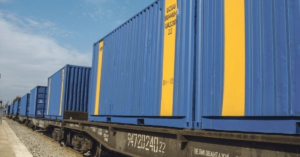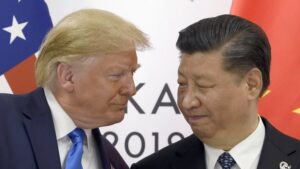
In 2024, Ukrzaliznytsia JSC (UZ) increased the volume of cargo transportation in containers by rail by 28% compared to the previous year – up to 258185 twenty-foot equivalent units (TEUs), said Valery Tkachev, Deputy Director of the Commercial Department.
According to him, 162,725 TEUs (63%) were transported on export routes, imports amounted to 55,689 TEUs (21.3%), domestic transportation – 38,681 TEUs (15%), and transit – 1,190 TEUs (0.5%).
The leader among cargoes in terms of containerized transportation was grain cargo, which accounted for 46% of the total volume of transportation, ferrous metals – 20%, oil cake – 9%, oil – 8%, sugar – 4%, synthetic resins – 3.7% and starch and molasses products – 3.6%.
Tkachev noted that one of the main trends in intermodal transportation through Ukraine in 2024 was the absence of a seasonal/peak increase in cargo transportation in November-December, although this period is usually characterized by a seasonal increase in transportation.
According to the UZ representative, the possible reasons for this phenomenon were the low cost of using grain cars – UAH 200-300 per day, which prompted farmers to return to using this type of cargo transportation. Also, due to the reopening of seaports, grain exports have been reoriented – 86-92% of grain is exported through seaports, and grain is transported to ports in grain wagons.
The reduction in the cost of using grain wagons also led to a decrease in the volume of grain cargo transportation in containers in the second half of 2024.
Tkachev also added that the share of rolling stock used by Liski, in particular, fitting platforms, decreased by 24%.

The Antimonopoly Committee of Ukraine (AMCU) has authorized Agrolife GmbH (Hamburg, Germany) to acquire a stake of more than 50 percent in AMBER AGRO LLC (Mykolaiv).
According to the committee’s website, the AMCU made the relevant decision at a meeting on Thursday.
According to the data of Opendatabot service, Amber Agro LLC was established in 2008 in Nikolaev. It specializes in the cultivation of grains and legumes, oilseeds, as well as the production of ready-made animal feed.
The company’s revenue in 2023 amounted to UAH 19.33 mln, net loss – UAH 9.79 mln, debt obligations – UAH 49.52 mln. Assets are estimated at UAH 16.68 mln. The company employs 19 employees. The authorized capital is UAH 3.02 million. The ultimate beneficiary through the Cyprus-based Inkomela Limited is Boris Skiba. Earlier he was listed among the beneficiaries of Agrolife GmbH.
Agrolife GmbH, according to information on its website, is a supplier of oilseeds, grains and feed additives for livestock on the markets of Germany, the EU and Ukraine. Agrolife GmbH together with Danish Fermentationexperts AS are the founders of European Protein Ukraine LLC (Kiev region).

US President Donald Trump said that he has “always liked” Chinese President Xi Jinping and expressed hope for China’s help in a peaceful resolution of Russia’s war against Ukraine.
“I hope China will help us stop the war, particularly with Russia, Ukraine, and they have a lot of power over this situation. And we will work with them. And I mentioned that during our phone call with President Xi, and I hope we can work together and stop it,” he said during an online chat after a special address at the World Economic Forum in Davos on Thursday.
According to Trump, his administration “looks forward to getting along very well with China.”
The US leader also noted that he “really likes President Xi” Jinping. “I’ve always liked him. We’ve always had a very good relationship,” the US president added.

On Thursday, US President Donald Trump signed an executive order declassifying documents on the assassination of the 35th US President John F. Kennedy, Senator Robert Kennedy, and civil rights leader Martin Luther King Jr.
“More than 50 years after the assassinations of President John F. Kennedy, Senator Robert F. Kennedy, and Pastor Martin Luther King Jr. the federal government has not made all of its records related to these events public. Their families and the American people deserve transparency and truth,” the text of the decree reads.
The document emphasizes that within the next 15 days, the Director of National Intelligence and the Attorney General must submit to Trump a plan to fully disclose records related to the assassination of President John F. Kennedy, and within 45 days – those related to the assassinations of Senator Robert F. Kennedy and Martin Luther King Jr.

Spain has for decades been one of the most popular destinations in the world for migrants from all countries due to its mild climate, quality of life and employment opportunities. Spain’s migration policy has undergone significant changes in recent years, which directly affects the labor market and social infrastructure of the country.
According to the National Institute of Statistics of Spain, in 2024, the number of foreign nationals in the country exceeded 7 million people, which is about 15 percent of the total population. Among the main groups of migrants can be distinguished:
Moroccans. One of the largest migrant groups in Spain. Many migrants from Morocco are employed in agriculture, construction and services. They number about 1 million people.
Romanians. Romanian citizens are the second largest migrant group, reaching more than 700 thousand people. The main areas of employment are construction, logistics and services.
Britons. About 400 thousand British citizens live in Spain, most of them retirees, concentrated in the provinces of Costa Blanca and Costa del Sol. Young people, in turn, most often work in the tourism industry.
Italians. Over 300 thousand Italians live and work in Spain, mainly in large cities such as Madrid and Barcelona. Employment in this group is split between technology, education and gastronomy.
Latin Americans. Migrants from Colombia, Venezuela, Ecuador and Peru make up a significant proportion of the foreign population. They work in elderly care, home care, and retail.
Ukrainians. In 2024, the number of Ukrainians in Spain exceeded 200,000. Many of them are involved in construction, logistics and agriculture, as well as working in the IT sector.
Spain provides migrants with access to a number of social and economic programs. The main aspects of the assistance system include – registration and legalization. Migrants have the opportunity to obtain temporary or permanent residence permits. The main criterion is the presence of a work contract or proof of independent income.
Health care. All officially registered migrants are entitled to free health care. This is especially important for families with children and pensioners.
Education. Migrant children have access to public schools, and adults can take advantage of language courses and vocational training programs.
Housing programs. The state and municipalities offer rental support, especially for low-income families.
Social benefits. Temporary payments are provided to migrants who find themselves in a difficult life situation, for example, when they lose their jobs.
Migrants play a key role in the Spanish economy, especially in agriculture, construction, hospitality and services. About 60 percent of migrants are employed in low-skilled sectors, while 20 percent work in high-tech industries. For example, EU nationals are more likely to be employed in IT and education, while migrants from Latin America and North Africa are more likely to be employed in construction and elderly care.
Over the past ten years, Spain’s population has shown moderate growth due to migration flows. While the population was around 46.5 million in 2013, this figure rose to 48 million by the end of 2024. The growth has been driven by an increase in the number of migrants, who are compensating for the natural population loss caused by the decline in the birth rate. In particular, nationals from Latin America and Eastern Europe have played a significant role, as well as a steady influx of Maghreb nationals.
Spain continues to be one of the leading countries in Europe in terms of the number of migrants. Their integration into the country’s economy allows it to maintain growth in key sectors despite demographic challenges. Increased competition in the labor market is expected in the future, especially in low-skilled sectors. However, thanks to a balanced migration policy, Spain has a good chance of maintaining stable population and economic growth.
http://relocation.com.ua/analiz-mihratsii-v-ispanii-u-2024-rotsi-vply/

The administration of the new US President Donald Trump is taking the first steps to change the regulation of the cryptocurrency market. During his election campaign, Trump promised to create a more friendly environment for crypto assets.
Mark Ueda, the acting chairman of the U.S. Securities and Exchange Commission (SEC), announced the creation of a working group to “develop a comprehensive and clear regulatory framework for crypto assets.”
“The task force will help the SEC define clear regulatory boundaries, propose realistic pathways for registration, develop reasonable disclosure schemes, and prudently allocate resources for enforcement,” the regulator said in a statement.
Ueda is acting as SEC chairman temporarily while Trump’s nominee, lawyer Paul Atkins, awaits confirmation by the Senate.
Earlier, the Experts Club think tank, Brian Mefford and Maxim Urakin, released a video analysis of what changes await US domestic and foreign policy under Trump, the video is available on the Experts Club YouTube channel – https://youtu.be/W2elNY1xczM?si=MM-QjSqGce4Tlq6T